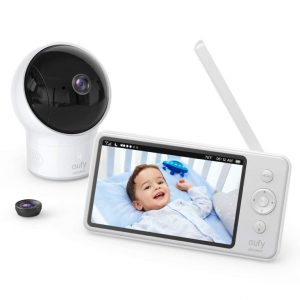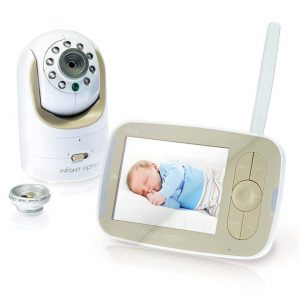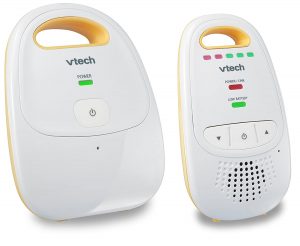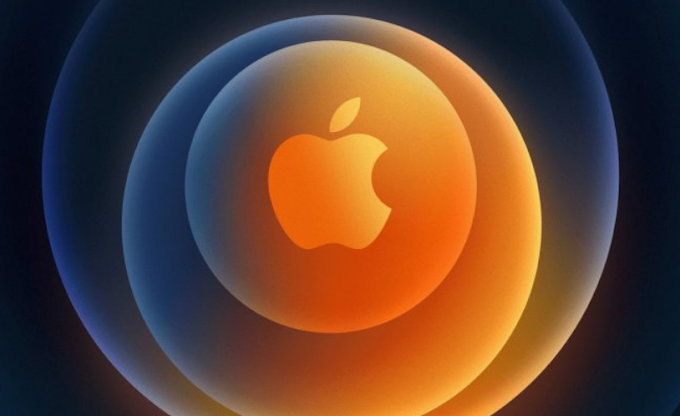Not everyone needs a baby monitor. If you live in a small home, your baby can sleep close to you and you won't usually feel the need to monitor him while he sleeps using a screen.
Other people may want to have a projector to use only occasionally, for example when they are out in the yard while the baby is sleeping. However, monitoring the baby is part of daily life for many parents, it is important for them to ensure that the child sleeps safely throughout the night so that they can get out of the room and relax.
The baby monitor provides a camera and/or microphone near the playroom and a separate rechargeable main unit (in some models, the cell phone as the main unit) that can be moved around the house.
Most screens are designed for home use, usually when a child is a few hundred meters away, but many people want to use the screen remotely (while working, traveling, or with friends). In these cases, the Wi-Fi transmitter is the best option.
These models work great at home as well, but they can be more complex than radiofrequency screens, and their data security can be an issue because they're online.
Screen selection criteria:
Type: The ideal screen is the one that transmits video and audio over the radio frequency (RF), not the screens that send over Wi-Fi (which can be verified by phone) or devices that transmit only sound. However, the list shows models of all kinds.
Range: Range is the main disadvantage of the RF model because audio devices can maintain transmission from a greater distance, and Wi-Fi displays can be verified from anywhere with a smartphone. However, most screens work well in the distance from the children's room to the street exit.
Battery: It is recommended to purchase a model that can last overnight even without a charger, and of course battery consumption depends on the frequency of use and the functions provided by the screen.
Image and sound quality: It is recommended to purchase a model with a camera high enough to see the child's face in the dark from a distance of a few meters, of course in broad daylight. The screen itself doesn't have to be bulky, but it can be clearly seen in the cabinet.
Usage options: Easy, intuitive, and comfortable buttons, whether they are part of the touch screen or separate from it.
Camera Options: It is recommended to purchase a camera with a wide range of motion that can be adjusted to the child's position in the room.
Appendix: Some models are a system to which more devices can be added, thus monitoring the situation in a number of different rooms.
Best Baby Monitor: Eufy SpaceView
The launch of Eufy SpaceView in 2018 set a new standard for baby monitors in terms of video and photo quality, parent unit battery life and transmission range, user interface, and even the directions in which the camera can move. The only drawbacks are the shaky leg of the parent unit, which sometimes fails to maintain camera stability, and the fact that it's a relatively new screen that doesn't have a lot of reviews.
Transmission range and battery life alone suffice to set Eufy apart from other displays, even without the extra features it has. There is no doubt that Eufy works well even when there is a great distance between the screen and the main unit: Although Eufy claims that the intercom can last up to 140 meters, in reality, it will still be connected even if you walk to the end of the street. If you live in a big house and want to stay in touch all the time - choose Eufy.
Battery life is a more realistic way to compare devices, and that's where Eufy also stands out. The screen is charged via Micro-USB connection and does not require a charger plugged into the outlet, and the screen can be used without plugging in for 15 hours after it is fully charged. This is somewhat in line with the manufacturer's specifications: the Eufy display has a 2,900mAh battery.
Eufy also wins in picture quality. Eufy's 5 '' 720p LCD screen is roughly reminiscent of a smartphone screen rather than a baby monitor screen, and you don't have to be an expert to realize this. It is definitely amazing and one of the best screens on the market.
Eufy has a 330 ° horizontal range and 110 ° vertical range. This wide range also allows you to wipe out a common room with two children, for example, or to compensate for a camera accidentally moving out of place.
Eufy's user interface is more convenient than other screens and makes it look like a modern electrical device and not just a simple product. The menus are clear, colorful, and easy to navigate, the location of the buttons is simple and intuitive, and the screen displays room temperature and time - vital information that can be quickly obtained even when waking up in the middle of the night.
In 2019, Eufy added an option to purchase an additional system camera to allow multiple rooms in the main unit to be tracked. This is a great option but not always at an affordable price - the basic package (screen + main unit) is usually relatively expensive, and an additional camera will cost more.
Simple points that need improvement:
The thing that weakens the quality of Eufy is one of the simplest and most important parts of the parent unit - the leg. It is weak and extremely flexible and sits on the side rather than the center of the device, so it is very easy to drop it when you touch it or press a button. Consistency is a critical problem because it is possible for children to tamper with this device from time to time, and it is important that he can survive this encounter. As for durability, there are a number of complaints that the device’s antenna has disconnected after several months of use.
Another disadvantage is that when the screen is turned off, there is no visible indication of noise in the room. Obviously if there is noise you will hear it, but if the volume of the main unit is reduced you may not notice it. Other models have a light that indicates the sound level in the room, so you can notice it from a distance and when the unit is dim or there is noise.
Infant Optics DXR-8 Video Baby Monitor with Interchangeable Optical Lens
Infant Optics DXR-8 is an excellent display, with a simple, intuitive and easy-to-port interface, while maintaining image quality, price, and many other features comparable to those of the best competitors other than Eufy. One of the arguments in favor of the Infant Optics DXR-8 Monitor is that it is a very popular product that has received user support for many years.
The battery life of this screen - although shorter than that of Eufy - was for a long time its best. The manufacturer claims it can take 10 hours with the screen turned off and accidentally checking it. This model also charges via a Micro-USB connection, which sets it apart from competitors, some of which use ineffective and inconvenient chargers or even batteries that must be replaced.
The Infant Optics DXR-8 comes in at a 3.5-inch size of 240X320, which means that it does not reach the standard 720p screen from Eufy. Despite this, the image quality is good enough to notice detail in a child's room from 1.5 meters from the camera and in a completely dark room. Infant Optics DXR-8's user interface is basic, simple and intuitive and can be quickly navigated in all directions. The text on the screen is old and contains many symbols, but it is easy to remember it once you understand it. A set of four buttons is used to bring up the menu and make changes (volume, for example) without stopping the camera broadcast from appearing on the screen. Other small additions, such as a temperature display in the baby's room, distinguish this model from others on the market, but it does not display the time like Eufy.
The Infant Optics DXR-8 range is so good, one has to leave the house to lose connection with the screen. However, many users have had trouble maintaining reception, be it due to range issues or outages. Either way, Yoffi is clearly the leader in this area.
For the purpose of supervising multiple rooms, up to four cameras can be added in a separate purchase and are easy to attach to the wall. With a horizontal range of movement of 270 degrees and a vertical 120, the main unit can be used to scan all the cameras to monitor (or listen to) all.
The DXR-8 comes with two interchangeable optical lenses (standard lens and zoom lens) and a wide lenses can also be purchased. Three different lenses are beautiful, but in practice zooming into a standard lens suffices, and most people will probably settle for them. One drawback that should be noted is that in very few cases, the DXR-8 display causes problems that include image distortion or "dead" pixels.
Arlo Baby Monitor
Like most Wi-Fi monitors, Arlo Baby offers a number of capabilities unavailable on a simpler RF video screen like Eufy. You can access the camera remotely via your smartphone (or computer), you don't have to worry about finding and charging a main unit, and you can also store video online. Arlo is part of a strong and reliable network of security cameras, with better application support and customer service than Wi-Fi models. However, this device appears to be inconvenient.
The big difference between Arlo and Wi-Fi screens seems very simple, but it's actually quite a problem for anyone who uses the device every night: Arlo can emit audio from the device directly to the phone even when the screen app is in the background, unlike many Other smart phone-connected devices that only work when the app is in use. This allows for easier use of Arlo, but you have to remember to charge your phone. Turning on screen audio alone can drain approximately 70 percent of your battery while you sleep.
The main advantage of devices that work on Wi-Fi is the ability to check the status of children with video remotely, which is essential for working parents or when going on a trip and children staying with grandparents. This is a function that is not found in nearly any other model. The ability to store video in the cloud is another unique feature of this model.
Arlo, like the previous models on the list, displays the temperature in the room (it does so in more detail, measuring humidity and air quality) and has good "night vision". Arlo, unlike other models, has the option of colorful night lighting, which may seem like an insignificant addition but is actually very nice and fun for a child's room.
But Arlo can be annoying, too. Aside from the night lighting, the other additional features are hardly useful at all. In addition, its reception causes a lot of problems, and sometimes you have to exit the application and log in again, or the application freezes or crashes.
Another difference is that the Arlo cannot be rotated sideways like other models, so once positioned this is the image you'll see. But it has a field of view wide enough to see the room well, and it has a wall mount surface to allow for more varied locations. You can also separate the bunny's ears and the bunny's legs that come with it if they block the line of sight, or if you want the device to look more like a camera rather than a toy.
another difference is that the Arlo cannot be rotated sideways like other models, so once positioned this is the image you'll see. But it has a field of view wide enough to see the room well, and it has a wall mount surface to allow for more varied locations. You can also separate the bunny's ears and the bunny's legs that come with it if they block the line of sight, or if you want the device to look more like a camera rather than a toy.
Compared to other Wi-Fi screens, Arlo has several advantages. As a well-known brand of home security cameras, the company provides better support for the hardware itself and the applications and has had a solid reputation for years. One can see this clearly among the plethora of sympathetic reviews of Arlo products in relation to other monitors.
Arlo's data security is an important issue to be aware of, as the chances of someone breaking into the device's transmission process are possible, but very low. But we can rely on it just as we rely on the data security of our home network.
Arlo can be controlled via multiple platforms, including Alexa, HomeKit, Google Assistant, and IFTTT. The device itself can work wirelessly for several hours using a rechargeable battery and can monitor the temperature or humidity in a room for several days. The device can be set to notify if there is a change in temperature, humidity or air quality. If Arlo gives messages a lot, you can also change the alerts settings (by raising the temperature limit, for example).
Another advantage of this model is that when it finishes its function as a baby monitor, it can be used as a home security camera, because this company specializes in it and using it over the phone is particularly convenient.
Best Choice - VTech DM111 Audio Baby Monitor
VTech DM221 is a very popular non-video audio monitor equipment which receives very positive reviews. Inexpensive video monitors are especially disappointing, so if you are on a relatively tight budget, it is a good idea to choose a high-quality audio device.
The sound quality of the VTech DM221 is impressive, and it is superior to video surveillance equipment. The battery lasts about 19 hours since a full charge, so it easily defeats the rest of the batteries on the list (although this isn't a completely fair comparison, as it only transmits sound). Additionally, it transmits sound to a range of 300 meters - a clear victory over the other models.
Compared to other audio monitors on the market, VTech has at least one key advantage that sets it apart easily - either it transmits longer, has a more convenient power supply (others require AAA batteries or cables), or they cost less.
The most frequent complaint about this model relates to connection problems, such as difficulty initiating the connection or being disconnected randomly during use. However, these complaints are few when compared to the positive reviews. Battery life can vary widely: in "standby" mode, where the device is not receiving sound, the batteries can last for about 4 days. In "normal" mode, where the device picks up the sound and uses the lighting functions, the battery lasts about 7 hours. Battery life and user-defined sensitivity levels also affect battery life.








0 Comments